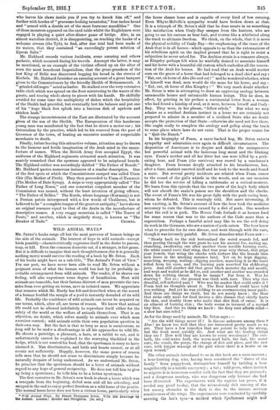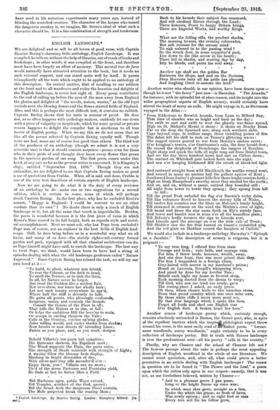WILD ANIMAL WAYS.•
Dia SETON'S books range all but the most perverse of human beings on the side of the animals. The interest of boys in wild animals—except birds possibly—characteristically expresses itself in the desire to pursue, trap, or kill. Even the common domestic eat, if a stranger, is fair game. But it is difficult to imagine that such thoughtlessness (for it is generally nothing more) would survive the reading of a book by Mr. Seton. Each of his books might have as a sub-title, " The Animal's Point of View." For our part, we have never been able to read Mr. Seton without a poignant sense of what the human world has lost by its probably in- evitable estrangement from wild animals. The reader, if he shares our feeling, will also experience some degree of humiliation. Most wild animals are tameable, but their furious distrust of man prevents the two sides from ever getting on terms, save in isolated cases. We appreciate that remorse which Mr. Hardy has felt and described when at the sound of a human footfall the margin of a pool is instantly denuded of its wild life. Probably the confidence of wild animals can never be acquired on our terms, which, after all, are terms of reason. We know that animal life could not be allowed indefinitely to reproduce itself either for the safety of the world or the welfare of animals themselves. That is an objection, no doubt, which refers mainly to animals over which man exercises control ; wild animals settle their own population question in their own way. But the fact is that so long as man is carnivorous, so long will he be under a disadvantage in all his approaches to wild life. He shoots a partridge, a pheasant, a hare, or a rabbit to eat, and it unfortunately cannot be explained to the scurrying blackbird in the hedge, which is not wanted for food, that the sportsman is sorry to have alarmed it. Man discriminates, and birds and beasts cannot, or at all events not sufficiently. Happily, however, the same power of reason tells man that he should not cease to discriminate simply because he naturally despairs of being understood. As we understand Mr. Seton, he preaches that the sportsman should be a lover of animals without regard to any hope of general reciprocity. He does not tell him to give up being a sportsman ; he tells him to be a better sportsman.
The first narrative in Mr. Seton's new book is about a horse which was a renegade from the beginning, defied man and all his schooling, and escaped in the end to enjoy perfect freedom as a wild horse of the prairie. The normal horse-lover does not love a vicious horse, particularly when
• Wild Animal Ways. By Ernest Thompson Seton. With 200 Drawings by the Author. Loudon: Hodder and Stoughton. [Os. net.] - the horse shams lame and is capable of every kind of low cunning. Even Whyte-Melville's sympathy would have broken down at that. It is a triumph of Mr. Seton's skill that he does create in us something like satisfaction when Coaly-Bay escapes from the hunters, who are going to use his carcase as bear-bait, and storms like a whirlwind along the track to ultimate freedom. We think, on the whole, that it is more the physical nobility of Coaly-Bay—the emphasizing of the trace of the Arab that is in all horses—which appeals to us than the extenuation of his rebellious spirit on the implied ground that he is right to resist a subjection he never asked for. The Arabian strain is a romance always, as Kingsley perhaps felt when ho wistfully desired to associate himself and his horse with a beautiful old custom which embodies all the venera- tion of the Arab for horses. He had read that an Arab would scatter corn on the grave of a horse that had belonged to a dead chief and say : "Eat, eat, oh horse of Abu (So-and-so) ! " and he wondered whether, when he himself was dead, men would do the same for his horse, and say : " Eat, eat, oh horse of Abu Kingsley ! " We very much doubt whether Mr. Seton is wise in attempting to draw an approving analogy between untameable horses and untameable human beings. This he does, in effect, by printing in his preface a sentimental letter from a woman who had found a kinship of soul, as it were, between herself and Coaly- Bay. They were, in her phrase, " fellow rebels." But what we may admire as a residual Arabian instinct in a horse we are certainly not prepared to admire in a member of a civilized State who no doubt accepts the protection of that State—otherwise she need not live there. She ought really to complete the analogy and gallop along the track to some place where laws do not exist. That is the proper course for a " Quit-the-Bunoh."
In his biography of Foam, a razor-backed hog, Mr. Seton extorts sympathy and admiration once again in difficult circumstances. The disposition of Americans is to despise and dislike the unimpressive but powerful animal with the ludicrous long snout and the blinking eyes. Foam's mother and all her litter but one were killed by a pork- eating bear, and Foam (the survivor) was reared by a ranchman's daughter. Foam became deeply attached to his benefactress, but, after a time, instinct asserted itself and he took to the woods and found a mate. But several pretty incidents are related when Foam comes to the sound of the girl's whistle in the woods, and on one occasion he did her the service of killing a rattlesnake at a critical moment. We learn from this episode that the two parts of the hog's body which will not absorb the snake's poison are the shoulders and the cheeks. The event of Foam's life was his great fight with tho pork-eating bear, whom he defeated. This is rousingly told. But more interesting. if less exciting, is Mr. Seton's account of how the bear took the medicine necessary to cure the diseases caused by a diet of pork. One wonders what the evil is in pork. The Mosaic Code forbade it as human food for some reason that was to the authors of the Code more than a superstition. Perhaps a fanciful mind may like to see the evil doing its work in the Germans, who are a nation of pork-eaters. The boar knew what to prescribe for its own disease, and went through with the cure, though it was intensely painful. Mr. Seton describes what Foam saw :—
" Slowly back to the rich bottomland the weird sounds led, and then peering through the wire grass ho saw his ancient foe, rooting up, crunching, swallowing one after another those terrible burning roots,
the white round roots that that tear your very throat, that gripe your bowels, that wring the cheeks with torture like the brands that men leave in the smoking summer land. Yet on he kept digging, munching, weeping, wailing—digging another, munching it as the tears rolled from his eyes, and the burning pain scorched his slobbering jaws. And still another did that great black monster dig and mouth, and wept and wailed as he did so, and another and another was crowded down his sobbing throat. Was he insane ? Far from it. Was he starving ? Not so ; the ground was thick with nuts. Then why this dreadful, self-inflicted pain 7 Who was his master that could order it ? Foam had no thoughts about it. The Boar himself could have told you nothing. And yet he was yielding to an overmastering inner guide. And these are things we think, but do not surely know : the Bear that seeks only meat for food invites a dire disease that chiefly hurts the skin, and doubly those who make that diet flesh of swine. It is an ailment of burning skin ; the body seems in torment of a myriad tiny fires. And this we think we know : the fiery root affords relief— a slow but sure relief."
As for the drugs used by animals, Mr. Seton says :-
" Are the wild things never ill ? Is disease unknown among them ? Alas ! we know too well that they are tormented pretty much as we are. They have a few remedies that are potent to help the strong, but the weak must quickly die. And what are the healing things
they use ? How well they are known to every woodsman ! The sun- bath, the cold-water bath, the warm-mud bath, the fast, the water cure, the vomit, the purge, the change of diet and place, and the rest cure, with tongue massage of the part where there is a bruise or an open wound."
The other animals introduced to us in this book are a coon-raccoon ; a bear-hunting dog, who, having been considered the " dunce of the family " from puppyhood, distinguishes himself by tackling a bear
magnificently in a terrific emergency ; a bat ; wild geese, whose instinct to migrate is in humorous conflict with the fact that they arc pinioned ; and a dangerous monkey, who was dangerous only because she had been ill-treated. The experiments with the captive bat prove, if it needed any proof to-day, that the miraculously deft steering of the
bat among obstacles in the dark is due to the intense nervous sensitiveness of the wings. The experiments were conducted by carefully covering the bat's eyes—a method which Spallanzani might well
have used in his notorious experiments many years ago, instead of blinding the wretched creature. The character of the keeper who tamed the dangerous monkey is, we imagine, Mr. Seton's ideal of what such a character should be. It is a fine combination of strength and tenderness.



































 Previous page
Previous page